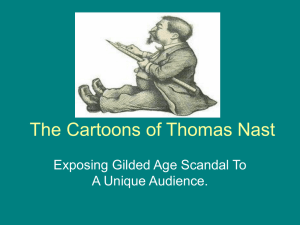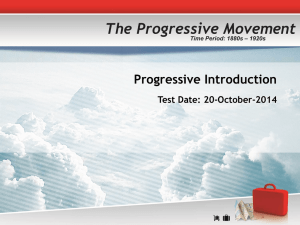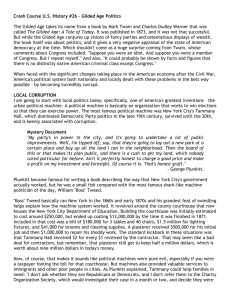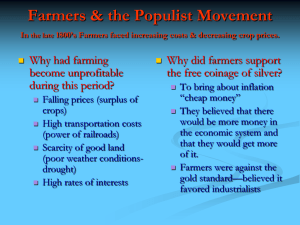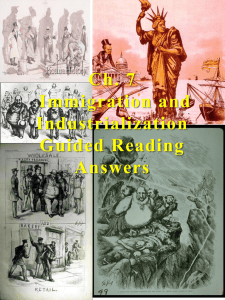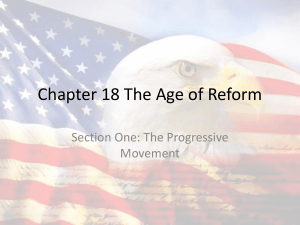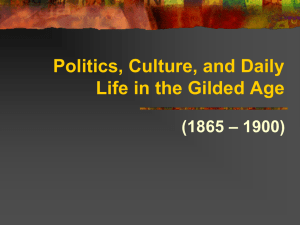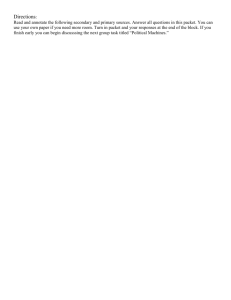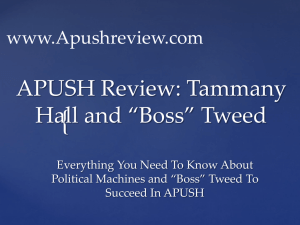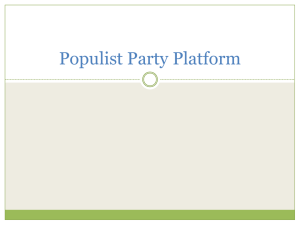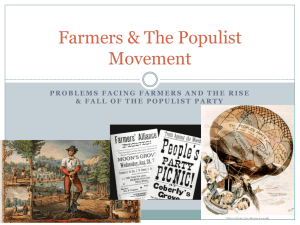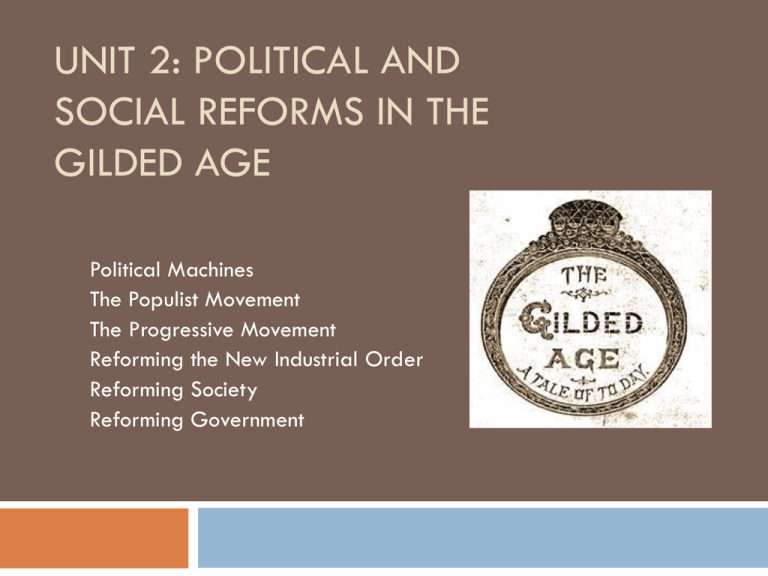
UNIT 2: POLITICAL AND
SOCIAL REFORMS IN THE
GILDED AGE
Political Machines
The Populist Movement
The Progressive Movement
Reforming the New Industrial Order
Reforming Society
Reforming Government
Intro. To the “Gilded Age”: 1870searly 1900s
All of part of the
recent trends of:
Industrialism
Big
Business
Immigration
Urbanization
Politics
Social
Reforms
Unit 1 (Ch. 6&7)
Unit 2 (Ch. 8, 9
&10)
Definition of “Gilded”
To cover with gold or gold leafing, and to give a bright
or pleasing aspect to
During the Gilded Age, life was made to seem
wonderful, but underneath the surface there were many
problems
Labeled the “Gilded Age” by Mark Twain
Problems of the Gilded Age: Review
Life in the big cities
Cultural diversity/immigration
Behavior of big business corporations
Behavior and role of labor unions
Behavior and role of laissez-faire government
Ideas of capitalism and Social Darwinism
Many pros and cons regarding these issues
Attempts to Reform
“Participatory Democracy”
1) “Grass Roots” Efforts:
-Political, social, economic actions by citizens
-Protest movements and organizations
2) Social Reform Movements
-Populist Movement and Populist Party
-Progressive Movement and Political Party
3) Actual Government Actions
-Acts and Laws
-Court cases and Supreme Court decisions
Increase in Population…
Put high demands on city governments
Fire
Police
Sanitation
Departments
Construction
Utility Systems (sewage, water, etc)
BUT
Laissez Faire = No real government action
The Rise of Political Machines
District representatives
and city council
members took charge of
public services
Often times, they
pocketed money meant
for the public
Political Machines
Well organized political parties that dominated
local and state governments
Party Bosses: Men who ran political machines
Provided jobs, favors and services to local residents
Most famous political machine was known as
Tammany Hall in New York City
Tammany Hall
Tammany Hall, cont’d…
Democratic Party machine that controlled NYC
politics
Helped immigrants rise in American politics (most
notably, the Irish)
Provided immigrants with an early version of the
welfare system
Tammany Hall, cont’d
Tammany Hall provided the following for
immigrants:
Welcome
upon arrival
Temporary housing
Jobs
Citizenship
Funerals
Tammany Hall, cont’d
Why would a political machine like Tammany Hall
“prey” on immigrants?
•Represented a HUGE supply of
supporters and voters
•Tended to be very loyal
William “Boss” Tweed
Head of Tammany Hall in
the late 19th Century
Found to have stolen
$40-$200 Million from
New York City taxpayers
through corruption
How Did They Profit?
Election fraud (stuffing ballot
boxes)
Intimidating voters
Graft: Acquiring money or
political power through illegal
or dishonest methods
Kickbacks: Payments of part
of the earnings from a job or
contract
Thomas Nast & The Tweed Ring
Thomas Nast was a political cartoonist who
despised Boss Tweed and Tammany Hall
Chose to utilize cartoons because many immigrants
couldn’t read!
Created the Republican Elephant and the
Democratic Donkey (and the modern day version of
Santa!)
Tammany Hall: Boss Tweed
Role of Thomas Nast (like Jacob Riis)
Pendleton Civil Service Act 1883
Similar
to Sherman Anti-Trust Act
The Populist Movement
Farmers (like workers, immigrants, and minorities)
suffer:
Ignored
by government
Poor
Isolated
and alone
Not respected
Not really represented
The Populist Movement, cont’d…
Major issue for farmers=DEBT
Technology
increases production
Farmers borrow money to purchase new technology
All farmers do this
THUS Overproduction
THUS Prices fall (Law of Supply and Demand)
THUS Farmers borrow money
THUS Farmers go into more debt
Railroad monopolies overcharge farmers for shipping
and storage
Farmers Organize
National Grange:
1867:
Oliver Kelley
Social
Organization and formation of cooperatives
Pressure RR companies to regulate shipping and
storage rates
Farmers’ Alliance Movement 1870s:
Led
by Mary Elizabeth Lease
Demanded graduated income tax
Provided low cost insurance
Pushed for tougher regulations on RR
Farmers Organize
Greenback Party—1870s
Populist Party:
1890:
James Weaver
Pushed
for a graduated income tax
Pushed for banking regulation
Wanted government ownership of RR (=Socialism)
Wanted coinage of silver
Wanted restricted immigration
Wanted shorter work day
Wanted voting reforms
Populist Movement, cont’d
William Jennings Bryan
(Populist Democrat) ran
against William McKinley
(Republican) in the
election of 1896
Bryan lost and McKinley
took office
Signaled the end of the
Populist Party
The Progressive Movement
Industrial Age = Major Advancements
Industrial Age = Major Problems
Basic levels at which reform can occur
Grass-roots
level = Individuals
Org. level = Reform movements
Gov. level = Laws, acts, court cases
Populist MovementProgressivism
Main concerns:
Big
gap between rich and poor
Bad urban conditions
Bad working conditions
Social problems
Political problems
Desire
for more “democracy”
Desire more participation
Government authority from the people
Progressive Profile
Native born
Middle or Upper Class
Usually from Urban areas
College Educated
Muckrakers
Investigative journalists
who wrote about
corruption in business and
politics, hoping to bring
about change and
reforms
Reforming the New Industrial Order
Harsh working conditions/hours, pay
Realities for women and children
Attempts at reform-push for new labor laws
Government
Florence
involvment
Kelley (1893): Anti-Child Labor Laws
National Child Labor Comm. (1904)
Rose Schneiderman—Triangle Shirtwaist Fire (1911): New
York passes fire safety codes
Supreme Court Cases: Inconsistent
Lochner v. New York (1905)
10
hour workday overturned
Muller v. Oregon (1908)
Some
limits upheld for hours worked
Role of Louis Brandeis
Use of scientific research and evidence
Labor Unions
Closed shops: Union membership required
Freedom of Contract: Workers can negotiate terms
of their contract with bosses
AFL: American Federation of Labor
ILGWU: International Ladies Garment Workers
Union
IWW: Industrial Workers of the World/Wobblies
Reforming Society
Urban Reforms: Basically Make the cities healthier
and more livable
State
Tenement Housing Association
National Tuberculosis Association
Daniel Burnham—building codes
Playgrounds, parks, etc.
Reforming Society, cont’d…
Moral Reforms: Basically prohibition
Anti-Saloon
League
Woman’s Christian Temperance Union-Carrie Nation
Frances Willard
Reverend Billy Sunday
Eventually: 18th Amendment (1919)—Volstead Act
Reforming Society, cont’d…
Racial Reforms: Against discrimination
W.E.B.
DuBois/Booker T. Washington
NAACP—1909—use of courts for
equality
Guinn
v. United States (1915)
Outlawed “grandfather clauses”
Buchanan
v. Warley (1917)
Overturned housing segregation
National
Urban League (1911)
Fought
for racial equality in jobs and
housing
Society
of American Indians (1911)
Problems for Women
Lacked the right to vote until 1920 (known as
women’s suffrage)
19th Amendment states that the government cannot
deny a person their right to vote based on sex
Reforming Government
If we are cleaning up cities, workplaces, and racial
discrimination, then why not “clean up government”?
Main idea of Progressives: Make system more fair!
Give
government back to the people
Make political process more democratic
Specific Political Reforms
Pendleton Civil Service Act (1883)
Direct Primary: People nominate politicians
17th Amendment: Senators elected by the people
Secret Ballot: All candidates are on one uniform
ballot
Initiative: People introduce laws themselves
Referendum: Citizens can put newly created laws on
the ballot for societal approval/disproval
Recall: Enables voters to remove an elected official
from office
Reforming Cities: Progressive Mayors
Samuel Jones: Toledo (1897)
Tom L. Johnson: Cleveland
Use of city commissions, managers
Galveston
1900
Robert LaFollette: the “Wisconsin Idea”
Amendments to the Constitution
Civil War through Reconstruction: 1865-1870
13th
Am. (1865): Abolition of slavery
14th Am. (1868): Due process/equality for citizens
15th Am. (1870): Voting rights cannot be denied due to
color of skin: Suffrage for African American males
Amendments to the Constitution,
cont’d…
Gilded Age/Progressive Era Amendments
16th
Am. (1913): Federal income tax
17th Am. (1913): Direct election of US Senators
18th Am. (1919): Prohibition of alcohol
19th Am. (1920): Suffrage for women
Even
US Presidents began to “reform” and adapt
progressive policies
Teddy Roosevelt
Wanted to use presidency as a “bully pulpit” to
further his own goals
Goals:
Conservation:
Preserve national parks and wildlife
Teddy Roosevelt, cont’d…
Goals, cont’d:
Improve
life for lower and middle class
Original “trust-buster”
Every American deserves a “Square
Deal, no more, no less”
Used “arbitration” to settle disputes
(third party gets involved)
William Howard Taft
Did not want to overstep his boundaries (unlike T.
Roosevelt)
Wanted to improve conditions for common man and
help working class
Not well liked
Called the White House the most lonesome place on
earth
Woodrow Wilson
Outspoken reformer who wanted Civil Rights and
working class reforms
Liked the idea of using the government as an agent
of change
Considered to be a “trust-buster” as well
(Known for being backed into corners!)

